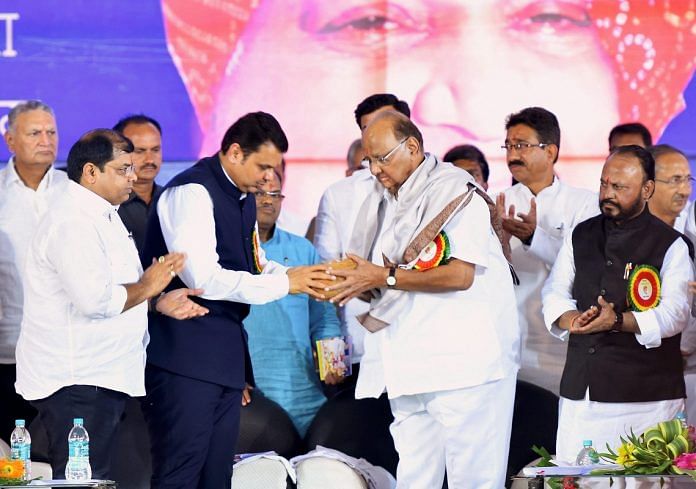Finance Minister insists performance has improved, cites farm loan waiver, power utilities’ debt for bad numbers this year.
Mumbai: Three years ago when the BJP came to power in Maharashtra for the first time in 15 years, it slammed the previous Congress-NCP government for what it said was leaving the state’s economy in a shambles. It even released a white paper in its first budget session, pointing to soaring revenue expenditure, mounting debt and inadequate capital expenditure.
As the Devendra Fadnavis government completes three years on 31 October, an analysis of its budgets shows that key financial indicators have largely remained unchanged from what they used to be under the Congress-NCP government. Moreover, with a farm loan waiver to be disbursed this year, compensation to urban local bodies due to the introduction of the Goods and Services Tax (GST), a squeeze on the capital expenditure, and the burden of the seventh pay commission, the financial situation is likely to turn even grimmer.
The BJP’s harshest criticism of the Congress-NCP government was regarding the state’s mounting debt, which had touched Rs 2.94 lakh crore by the end of the alliance government’s tenure in October 2014.
Even as the Fadnavis-government promised fiscal consolidation, the outstanding debt has only soared and is estimated to breach the Rs 4.13 lakh crore projected in the budget for 2017-18. Meanwhile, the debt as a percentage of the Gross State Domestic Product (GSDP) has hovered around the same levels as the last three years of the Congress-NCP government.
However, Maharashtra’s debt to GSDP ratio is still well within the limits set by the 14th Finance Commission for states to be eligible to raise their fiscal deficits by half a percentage beyond the existing cap.
Fadnavis’ predecessor, Prithviraj Chavan, said, “When the BJP accused us of building a mountain of debt, I challenged them to reduce even one rupee of debt over one year and I would resign. Now, the debt has crossed the Rs 4 lakh crore mark and servicing it is going to be a problem over a period of time. Government finances are in a shambles and overall not enough attention has been paid to revenue growth.”
Also read: The Devendra Fadnavis government is a total failure, says Prithviraj Chavan
The white paper also blamed the previous government for a muted capital expenditure that crippled development. It said other big states in the country spend up to 3 per cent of the GSDP on capital expenditure — the money spent on creating, upgrading and maintaining physical assets, which is the parameter to look out for to gauge the expenses on infrastructure.
An analysis of the actual capital expenditure from 2012-13 to 2015-16 shows that the spend has always been between 1.2 and 1.6 per cent of GSDP, even after the BJP government came to power in October 2014. The ballpark figure for 2017-18 remains gloomy. State finance minister Sudhir Mungantiwar initially estimated the capital expenditure for 2017-18 to be Rs 35,504.36 crore.
However, following the declaration of a Rs 34,022-crore farm loan waiver, the government in June decided to slash the planned spend by 20 per cent, bringing down the capital expenditure estimates to Rs 28,403 crore, or about 1.12 per cent of the estimated GSDP.
While announcing the cut in capital expenditure, the state finance department in a resolution said, “The state government has announced a scheme for loan waivers and benefits to farmers. It is expected that the state will incur a cost of Rs 34,022 crore to give these benefits. Likewise, the state has to give Rs 13,000 crore to municipal corporations every year as compensation for doing away with octroi and local body tax due to the newly-implemented GST. Since this expenditure has to be made on priority, it has become imperative for the state government to exercise control on the budgeted expenditure.”
“There is an automatic ceiling if most of the states are following fiscal responsibility norms. The challenge is that because some states are favouring certain types of expenditure, like a farm loan waiver, the quality of expenditure suffers,” said Samiran Chakraborty, chief economist (India) at Citibank.
“States then have to cut capital expenditure to stay within the fiscal responsibility norms. I am more worried about the quality of expenditure deteriorating,” he said.
Chakraborty was speaking at a panel discussion organised by the National Stock Exchange and the International Monetary Fund Tuesday.
The state’s fiscal deficit too has been in the same 1.6-1.9 per cent range for the past five years, well under the 3 per cent cap.
But Mungantiwar defended the performance of his government.
“This year the figures are such because of unavoidable circumstances. If we only look at the past two years, we have definitely managed to increase the capital investment and our performance for the first two years was much better than the previous government,” he told ThePrint.
“This year, we had to choose between making capital investment and attending to farmers’ distress, so we consciously chose the latter. Besides, the total debt is also high because we have now taken the state’s electricity distribution company’s debt on our books.”
He added that over the next two years the government’s focus would be to improve spending on basic infrastructure for agriculture, other capital infrastructure, industries, employment and tourism.



